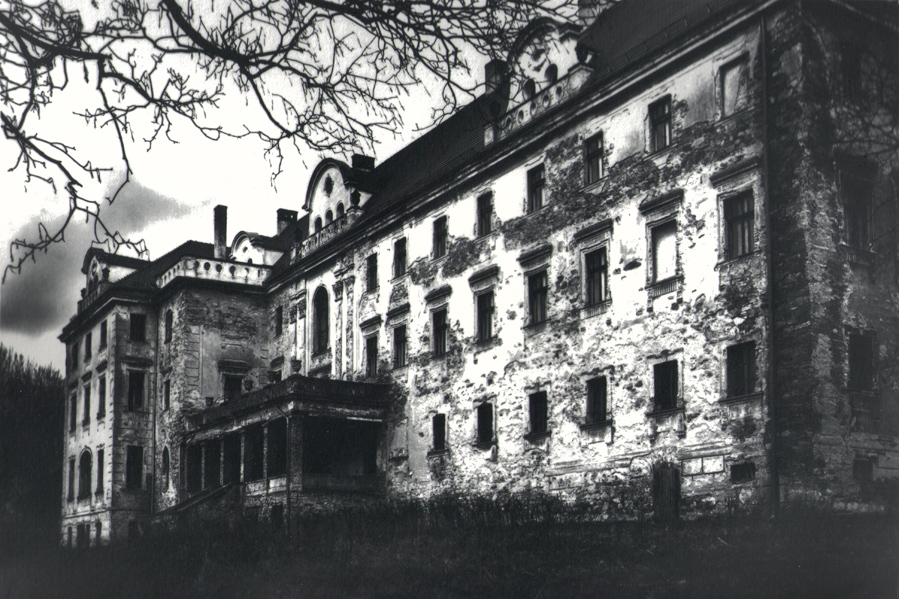 Carbon transfer is one of the most important (and beautiful) historical processes; along with gumprint and oilprint it is one of the essential techniques utilizing the light sensitivity of organic coloids sensitized with chromium salts. In the past, materials for carbon transfer used to be manufactured by the Autotype company (hence the other name of the process), today, they need to be manufactured by the photographer. As a curiosity, best attesting to the prestige the process used to be accompanied by, it should be remembered that many photographers of the past would offer their customers a choice of technique that would be used to make the prints they ordered. If the customer was less demanding (and less willing to spend money), one of the cheaper and simpler processes, such as the albumen print, would be used. Carbon transfer, along with the platinum print, would have been reserved for the most demanding customers who were willing to pay considerably more. Even though, similarly to the gumprint, carbon transfer utilises the fact that organic coloids, in this case gelatin, sensitized with potassium or ammonium bichromate change their properties and lose solubility in water, this is where similarities end. Carbon transfer prints, even those made from a single layer, are characterised by deep blacks, powerful expression and reach detail combined with subtle tonal variations. Carbon transfer combines power and subtlety and is equally suited to dramatic landscapes, medieval ruins an delicate female nudes. Today, after years of near oblivion, the process once more comes to favour offering advantages unattainable to most photographic processes, such as: excellent, almost unrivalled permanence of hundreds of years...
Carbon transfer is one of the most important (and beautiful) historical processes; along with gumprint and oilprint it is one of the essential techniques utilizing the light sensitivity of organic coloids sensitized with chromium salts. In the past, materials for carbon transfer used to be manufactured by the Autotype company (hence the other name of the process), today, they need to be manufactured by the photographer. As a curiosity, best attesting to the prestige the process used to be accompanied by, it should be remembered that many photographers of the past would offer their customers a choice of technique that would be used to make the prints they ordered. If the customer was less demanding (and less willing to spend money), one of the cheaper and simpler processes, such as the albumen print, would be used. Carbon transfer, along with the platinum print, would have been reserved for the most demanding customers who were willing to pay considerably more. Even though, similarly to the gumprint, carbon transfer utilises the fact that organic coloids, in this case gelatin, sensitized with potassium or ammonium bichromate change their properties and lose solubility in water, this is where similarities end. Carbon transfer prints, even those made from a single layer, are characterised by deep blacks, powerful expression and reach detail combined with subtle tonal variations. Carbon transfer combines power and subtlety and is equally suited to dramatic landscapes, medieval ruins an delicate female nudes. Today, after years of near oblivion, the process once more comes to favour offering advantages unattainable to most photographic processes, such as: excellent, almost unrivalled permanence of hundreds of years...
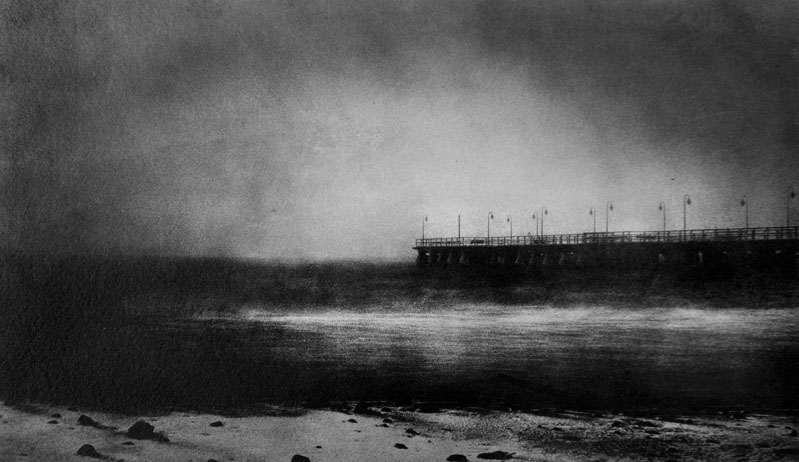 If you have had enough of typical courses with participants diligently copying negatives previously prepared by the tutor and all leaving the workshop with identical pictures that are not really theirs; if you don’t want to go for a course lasting from 10a.m. till 6 p.m. where the cleaning lady pointedly enters the room half an hour before the end, we have a perfect offer for you. Join the workl of alternative photography learning the intricacies of one of the most important of them all, of the oilprint. Take part in a workshop during which you will not only work using the instructor’s negatives but will, above all, be able to prepare your own negatives that you will subsequently copy as oilprints with the help of an experienced instructor using the oilprint at the same time learning the secrets of the process and making your own art. Above all, the fact that the workshop lasts three days, it will not only offer an opportunity to learn the basics, but also to get practice in printing. Constant supervision and assistance from the tutor will make it possible to notice and eliminate errors as they appear. Oilprint is one of the most important alternative processes, popular especially with the great pictorial photographers. It allows unrivalled manual control over the final appearance of the print combined with a wonderful rendition of details. Experience acquired with oil printing will also prove priceless when you try the sister process of bromoil. We will begin the workshop by learning how to prepare our own materials, especially the papers which will later be used to create the prints....
If you have had enough of typical courses with participants diligently copying negatives previously prepared by the tutor and all leaving the workshop with identical pictures that are not really theirs; if you don’t want to go for a course lasting from 10a.m. till 6 p.m. where the cleaning lady pointedly enters the room half an hour before the end, we have a perfect offer for you. Join the workl of alternative photography learning the intricacies of one of the most important of them all, of the oilprint. Take part in a workshop during which you will not only work using the instructor’s negatives but will, above all, be able to prepare your own negatives that you will subsequently copy as oilprints with the help of an experienced instructor using the oilprint at the same time learning the secrets of the process and making your own art. Above all, the fact that the workshop lasts three days, it will not only offer an opportunity to learn the basics, but also to get practice in printing. Constant supervision and assistance from the tutor will make it possible to notice and eliminate errors as they appear. Oilprint is one of the most important alternative processes, popular especially with the great pictorial photographers. It allows unrivalled manual control over the final appearance of the print combined with a wonderful rendition of details. Experience acquired with oil printing will also prove priceless when you try the sister process of bromoil. We will begin the workshop by learning how to prepare our own materials, especially the papers which will later be used to create the prints....
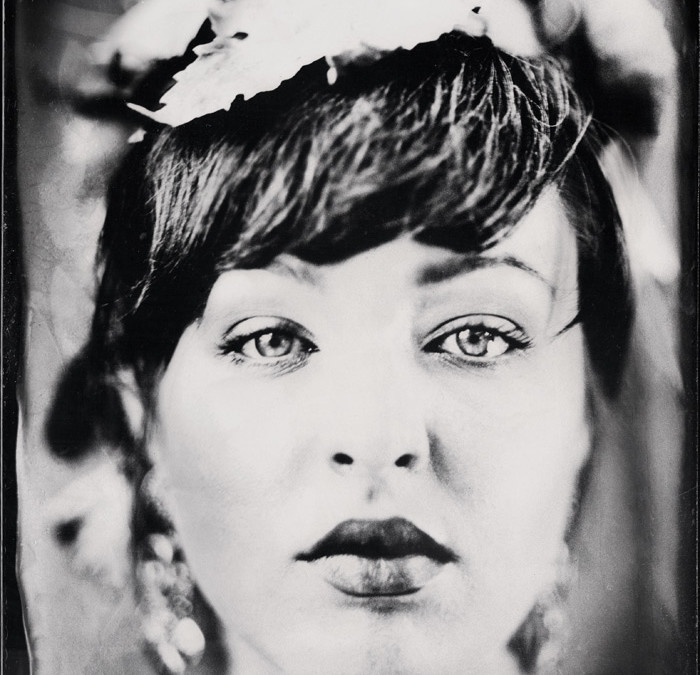 Discover the magic of the ambrotype together with the author of The Ambrotype – A Practical Guide – the first Polish textbook devoted to this fascinating process. Join our workshop and learn to make your photographs on glass using the methods of the masters of 1860’s and 1870’s, the methods used till this day by numerous photographers all over the world – to name just Sally Mann or Ian Ruhter. Learn all the necessary secrets of the process along with recipes and procedures enabling you to create unique works of art while discovering the charm of old photography. The magic of wetplate photography or, to be more specific, of ambrotypes, hasn’t passed for over 150 years which have passed since the invention of the technique. The image made of silver on glass, magical, glittering with subtle hues fascinates in the 21st century just as much as it did in the 19th. And just as it was in the times when it was invented, for most of us the technique still is a mystery, something almost mystical. It seems that it is even more of a mystery now than in the past. Our two-day workshop in making wetplate ambrotypes will not only allow participants to learn/revise the rules governing wetplate photography but will also offer practical opportunities to use these skills under the tutor’s guidance and with the help of professional models taking part in the workshop. The programme of the workshop covers: a quick revision of using large format cameras, a presentation of the wetplate ambrotype process including chemical recipes, preparing glass for ambrotype photography, coating glass with collodion, sensitizing,...
Discover the magic of the ambrotype together with the author of The Ambrotype – A Practical Guide – the first Polish textbook devoted to this fascinating process. Join our workshop and learn to make your photographs on glass using the methods of the masters of 1860’s and 1870’s, the methods used till this day by numerous photographers all over the world – to name just Sally Mann or Ian Ruhter. Learn all the necessary secrets of the process along with recipes and procedures enabling you to create unique works of art while discovering the charm of old photography. The magic of wetplate photography or, to be more specific, of ambrotypes, hasn’t passed for over 150 years which have passed since the invention of the technique. The image made of silver on glass, magical, glittering with subtle hues fascinates in the 21st century just as much as it did in the 19th. And just as it was in the times when it was invented, for most of us the technique still is a mystery, something almost mystical. It seems that it is even more of a mystery now than in the past. Our two-day workshop in making wetplate ambrotypes will not only allow participants to learn/revise the rules governing wetplate photography but will also offer practical opportunities to use these skills under the tutor’s guidance and with the help of professional models taking part in the workshop. The programme of the workshop covers: a quick revision of using large format cameras, a presentation of the wetplate ambrotype process including chemical recipes, preparing glass for ambrotype photography, coating glass with collodion, sensitizing,...
 Join the world of photographers passionate about the old photographic processes and take part in our workshop devoted to monochromatic gumprinting. Here you will discover the magic of the old processes, of photographs literally painted with a brush on pre-reated paper. Of photographs as painterly as no other prints, subtle and yet powerful. you will learn the trade of masters such as Steichen or Demachy. Gum bichromate is one of the oldest photographic techniques, older than the silver gellatine print most of us know. At the same time it is a pictorial technique, allowing the photographer a considerable degree of freedom of manipulation while creating the final print and thus enabling him to create visual effects unavailable in other techniques. It was, one could argue, created as an antidote to the mechanical perfection of reproduction and lack of ability to manipulate the resulting image in the other early photographic processes and as such it still works perfectly in the age of mechanical perfection of digital photography. As it requires much more work than silver or iron based techniques, gumprint was, with time, almost entirely replaced by the much less time consuming silver gellatine print which, in turn, lost its position to digital images. Yet today, when we have become tired of the super saturated, technically perfect digital images, gumprint has once more proved to be a perfect solution. Gum bichromate prints are unique and even their author is unable to make an identical copy; a quality that makes gumprints highly collectible and increases their value. The time and work required to create a single print also foster a special emotional reaction with...
Join the world of photographers passionate about the old photographic processes and take part in our workshop devoted to monochromatic gumprinting. Here you will discover the magic of the old processes, of photographs literally painted with a brush on pre-reated paper. Of photographs as painterly as no other prints, subtle and yet powerful. you will learn the trade of masters such as Steichen or Demachy. Gum bichromate is one of the oldest photographic techniques, older than the silver gellatine print most of us know. At the same time it is a pictorial technique, allowing the photographer a considerable degree of freedom of manipulation while creating the final print and thus enabling him to create visual effects unavailable in other techniques. It was, one could argue, created as an antidote to the mechanical perfection of reproduction and lack of ability to manipulate the resulting image in the other early photographic processes and as such it still works perfectly in the age of mechanical perfection of digital photography. As it requires much more work than silver or iron based techniques, gumprint was, with time, almost entirely replaced by the much less time consuming silver gellatine print which, in turn, lost its position to digital images. Yet today, when we have become tired of the super saturated, technically perfect digital images, gumprint has once more proved to be a perfect solution. Gum bichromate prints are unique and even their author is unable to make an identical copy; a quality that makes gumprints highly collectible and increases their value. The time and work required to create a single print also foster a special emotional reaction with...
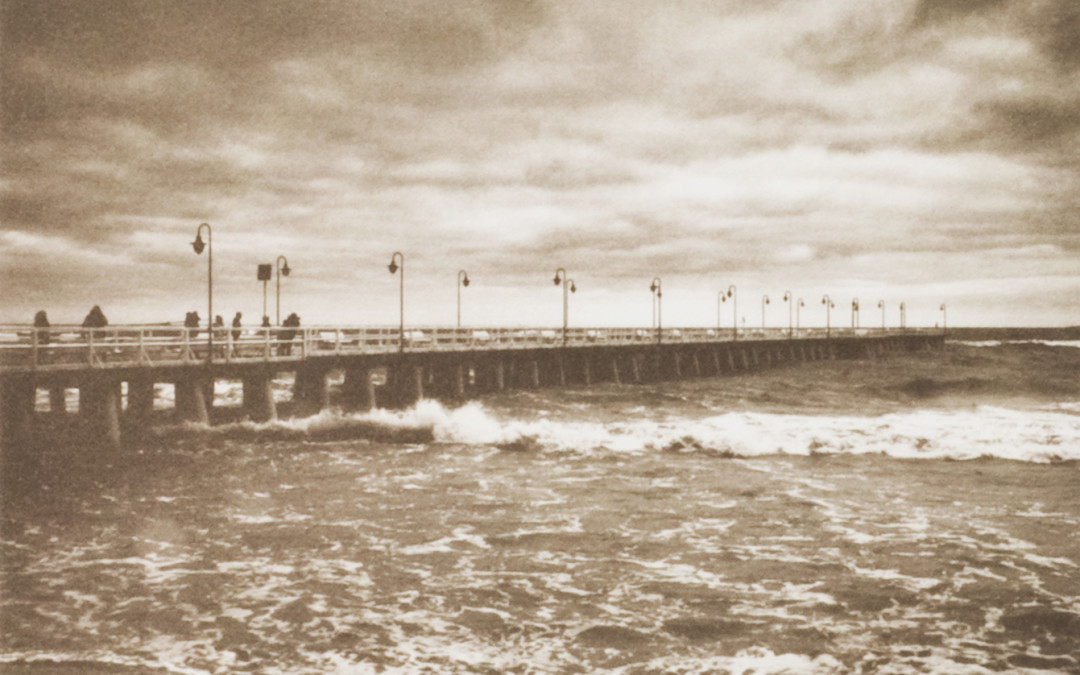 Take part in our only workshop devoted to the most luxurious of all iron based processes and learn the secrets of making photographs using platinum salts the way it was done by the greaters masters of photography. Learn the magic of historical photography, of working with self made light sensitive materials and learn to make prints with one of the most beautiful photographic processes, prints that will be both exquisitely subtle and outstandingly permanent. Platinum print and its sister technique palladium print are among the oldest, rarest and most permanent photographic techniques. They enable the artist to create pictures of amazing tonality, really unique ones of amazing permanence, limited only by the permanence of the paper they are made on. Small wonder this was the technique of choice of such masters as Edward Steichen or Irwin Penn. We’ve prepared a workshop which will enable participants to learn the intricacies of the process and start their own, independent work, taught by Radosław Brzozowski. who brought the process back to life in post war Poland. During the workshop you will learn the necessary recipes as well as to prepare negatives, sensitize papers, control contrast of your prints and, above all, to work independently The programme of the workshop covers: a theoretical introduction, presentation of platinum prints, preparing a digital negative for platinum printing tips on developing large format negatives for platinum printing, making palladium prints, making multilayered palladium prints, methods of preventing paper shrinkage and curling, print presentation, All the participants will be privided with: chemicals required for platinum and palladium printing, papers appropriate for platinum and palladium printing, all materials...
Take part in our only workshop devoted to the most luxurious of all iron based processes and learn the secrets of making photographs using platinum salts the way it was done by the greaters masters of photography. Learn the magic of historical photography, of working with self made light sensitive materials and learn to make prints with one of the most beautiful photographic processes, prints that will be both exquisitely subtle and outstandingly permanent. Platinum print and its sister technique palladium print are among the oldest, rarest and most permanent photographic techniques. They enable the artist to create pictures of amazing tonality, really unique ones of amazing permanence, limited only by the permanence of the paper they are made on. Small wonder this was the technique of choice of such masters as Edward Steichen or Irwin Penn. We’ve prepared a workshop which will enable participants to learn the intricacies of the process and start their own, independent work, taught by Radosław Brzozowski. who brought the process back to life in post war Poland. During the workshop you will learn the necessary recipes as well as to prepare negatives, sensitize papers, control contrast of your prints and, above all, to work independently The programme of the workshop covers: a theoretical introduction, presentation of platinum prints, preparing a digital negative for platinum printing tips on developing large format negatives for platinum printing, making palladium prints, making multilayered palladium prints, methods of preventing paper shrinkage and curling, print presentation, All the participants will be privided with: chemicals required for platinum and palladium printing, papers appropriate for platinum and palladium printing, all materials...
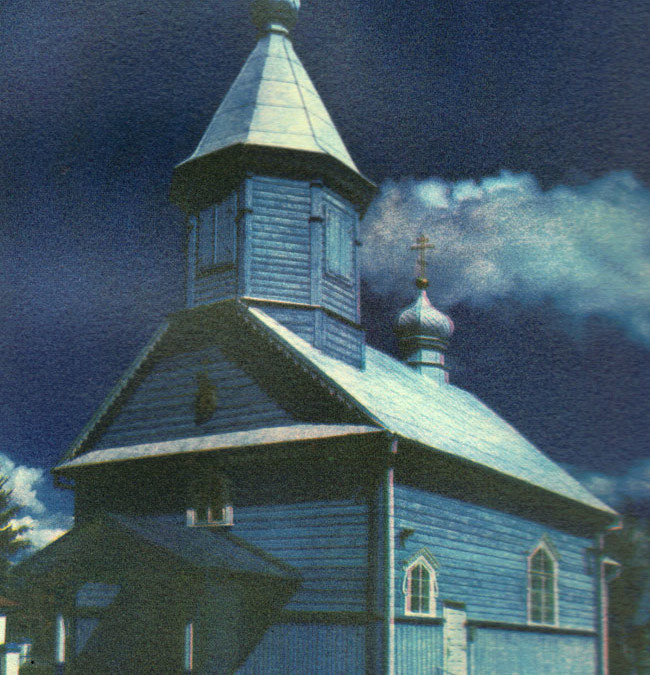 Pictorial photography – gumprint is one of the richest, most complete gumprinting workshops covering all key aspects of both monochromatic and colour gumprintng. Despite the fact over a hundred years have passed since its heyday, pictorial photography is still immensely popular, one could actually say it enjoys a revival. Pictorial pictures are delicate, romantic with this unmistakeable note of dreaminess and nostalgy. Many photographers, more or less consciously, try to stay within pictorial aesthetics, whether their photography is digital or classical, as this often leads to the creation of interesting photographs. Unfortunately, digitally made pictorial photographs hardly ever can match up to the original work of masters, at least partly due to the limitations of the technique itself. Our four day workshop will offer an opportunity to come closer to the original methods of the Old Masters as the pictures created during it will be made using similar equipment and techniques. Unlike most workshops devoted to gumprinting, this is a complete course with intensive practice covering all issues connected with gumprinting. This means we will not only cover monochromatic gumprinting but also making full colour prints and combining gumprint with iron based processes. The programme of our four-day workshop covers: an overview of the work of most important pictorialists/gumprinters, review/introduction of the most important pictorial techniques, especially gum bichromate, cyanotype and platinum combined with gumprint preparing papers for gumprinting, practical work on making a monochromatic picture; both single and multi-layered, learning to manipulate the gumprinted image, practical work on making full colour gumprints, making prints using the combination of cyanotype and gumprint, an overview of photographs taken during the...
Pictorial photography – gumprint is one of the richest, most complete gumprinting workshops covering all key aspects of both monochromatic and colour gumprintng. Despite the fact over a hundred years have passed since its heyday, pictorial photography is still immensely popular, one could actually say it enjoys a revival. Pictorial pictures are delicate, romantic with this unmistakeable note of dreaminess and nostalgy. Many photographers, more or less consciously, try to stay within pictorial aesthetics, whether their photography is digital or classical, as this often leads to the creation of interesting photographs. Unfortunately, digitally made pictorial photographs hardly ever can match up to the original work of masters, at least partly due to the limitations of the technique itself. Our four day workshop will offer an opportunity to come closer to the original methods of the Old Masters as the pictures created during it will be made using similar equipment and techniques. Unlike most workshops devoted to gumprinting, this is a complete course with intensive practice covering all issues connected with gumprinting. This means we will not only cover monochromatic gumprinting but also making full colour prints and combining gumprint with iron based processes. The programme of our four-day workshop covers: an overview of the work of most important pictorialists/gumprinters, review/introduction of the most important pictorial techniques, especially gum bichromate, cyanotype and platinum combined with gumprint preparing papers for gumprinting, practical work on making a monochromatic picture; both single and multi-layered, learning to manipulate the gumprinted image, practical work on making full colour gumprints, making prints using the combination of cyanotype and gumprint, an overview of photographs taken during the...








Recent Comments